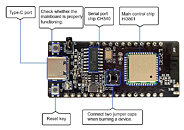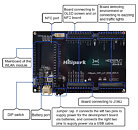Monday, May 24th 2021
HiSilicon Develops RISC-V Processor to Move Away from Arm Restrictions
Huawei's HiSilicon subsidiary, which specialized in the design and development of semiconductor devices like processors, has made a big announcement today. A while back, the US government has blacklisted Huawei from using any US-made technology. This has rendered HiSilicon's efforts of building processors based on Arm architecture (ISA) practically useless, as the US sanctions applied to that as well. So, the company had to turn to alternative technologies. Today, HiSilicon has announced the new HiSilicon Hi3861 development board, based on RISC-V architecture. This represents an important step to Huawei's silicon independence, as RISC-V is a free and open-source ISA designed for all kinds of workloads.
While the HiSilicon Hi3861 development board features a low-power Hi3861 chip, it is the company's first attempt at building a RISC-V design. It features a "high-performance 32-bit microprocessor with a maximum operating frequency of 160 MHz". While this may sound very pale in comparison to the traditional HiSilicon products, this chip is used for IoT applications, which don't require much processing power. For tasks that need better processing, HiSilicon will surely develop more powerful designs. This just represents an important starting point, where Huawei's HiSilicon moves away from Arm ISA, and steps into another ISA design and development. This time, with RISC-V, the US government has no control over the ISA, as it is free to use by anyone who pleases, with added benefits of no licensing costs. It is interesting to see where this will lead HiSilicon and what products the company plans to release on the new ISA.
Sources:
Huawei HarmonyOS Devices, via Tom's Hardware
While the HiSilicon Hi3861 development board features a low-power Hi3861 chip, it is the company's first attempt at building a RISC-V design. It features a "high-performance 32-bit microprocessor with a maximum operating frequency of 160 MHz". While this may sound very pale in comparison to the traditional HiSilicon products, this chip is used for IoT applications, which don't require much processing power. For tasks that need better processing, HiSilicon will surely develop more powerful designs. This just represents an important starting point, where Huawei's HiSilicon moves away from Arm ISA, and steps into another ISA design and development. This time, with RISC-V, the US government has no control over the ISA, as it is free to use by anyone who pleases, with added benefits of no licensing costs. It is interesting to see where this will lead HiSilicon and what products the company plans to release on the new ISA.



39 Comments on HiSilicon Develops RISC-V Processor to Move Away from Arm Restrictions
If, for example, ASML starts very slowly pulling its US assets into Europe and searching for non US partners ... you know why. And most probably TSMC had a talk with them about this, as did EU officials in an unofficial way.
China is a bully but so is USA. Let me be clear, I do not think they are the same but both are international bullies.
They still have modem/ routers on the home front to retain mind share and their phones and laptops are fairly good quality still
Going from 20% global smartphone marketshare to 4% in 3 quarters? That's dead. They're selling out existing stocks of decently specced phones (which they made a significant effort to build up when the ban was first put in place) and that is stopping them from dropping off the map entirely, but they are out of the running in every meaningful metric. Realme is the same size and Oppo is nearly 3x. And there's no reason to expect that trend to change either. Whether they have modems and routers (again, must be old stock, unless they're not ARM-based) and other peripheral products still available is largely irrelevant, as the size of those markets is nothing compared to the smartphone market. I agree that their laptops are good (and it seems like those aren't affected by the trade restrictions?), but they're a very small actor there, and the laptop market is still tiny compared to smartphones. They're diversifying in order to stay afloat (monitors, TVs, etc.), but the best case scenario is for them to continue operating at a tiny fraction of their previous size. Going from a global communications powerhouse across infrastructure and end-user clients to a me-too competitor in a dozen minor markets, even if they make good products? That's pretty dead in my book.
If you throw enough money around, Time isnt that much of a factor.
Up to now Huawei don't have a line for anything below 28nm. Or maybe we don't know about it, but pretty soon they will.
Do you guys really believe that all iPhone users care about the openly shady privacy practices? Or the million Android users who use Facebook, Instagram and what not on their phones, will be afraid of 'China spying on us? Ermahgerd!'
For mobile I think they are back on board with Samsung. More so, they still have huge political and monetary influence that nobody dares to pass on lightly.
I think Google are saving their next iteration of cr@py OS for exactly when Huawei goes all out on the mobile front.
True, they will be giving it for free to everyone but if everyone adopts RISC-V then they win. It a bit far fetched but it has some chance in it.